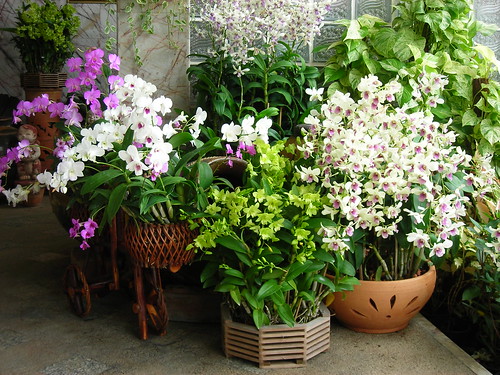
Orchids produce some of the most spectacular and intriguing flowers in the world, but they can also be among the most difficult plants to care for. Despite the challenge of maintaining them, orchids have a continuing popularity among plant enthusiasts, and there are a variety of orchids available for both the expert botanist and the novice orchid hobbyist.
You can probably find an orchid or two for sale at your local garden center at an affordable price, while specialty shops will carry orchids that are extremely rare and expensive. Whatever your level of commitment to nurturing an orchid, there are a few things that you can do to help your plant produce beautiful flowers.
Orchids are accustomed to warm, humid climates and usually require plenty of light. Whether you're raising your orchid in a greenhouse or keeping it in your office, be sure to choose a spot for your orchid where it will be warm without drying out. Above all,
make sure that your orchid receives enough sunlight to enable it to bloom.
Most orchids require a lot of exposure to sunlight, and failure to provide enough light will result in an otherwise healthy plant that simply doesn't bloom. However, the leaves of an orchid can become very sensitive to sunlight if they have been in low-light conditions for a prolonged period of time. Therefore, if you decide that your orchid is not getting enough light, move it little by little to an area with greater sun in order to avoid injuring the leaves with sudden overexposure.
When you water your orchid, make sure to thoroughly saturate the soil. Orchids like a moist environment, and allowing the plant to dry out could endanger its health. An orchid's soil should also not be too heavy, and there should be good air circulation around the base of the plant.
A certain mixture of orchid-specific nutrients is also essential for a healthy orchid, and you can purchase a substance called orchid bark to mix into the soil for potting your orchid. While supplying vital nourishment to your orchid, the addition of orchid bark will also improve air circulation through the soil, keeping your orchid beautiful.
If you truly want to appreciate your orchid, you will also have to understand that orchids do not flower all the time. After your orchid has flowered, you will need to care for the plant until it is ready to flower again. Once the blooms have faded, you should cut off most of the stem, leaving at least an inch intact. As long as you give your orchid adequate nourishment, water and light throughout its growing cycle, it will
eventually flower again.
Over time, you may find that you want to expand your collection of orchids to include more exotic and challenging varieties. Orchid nurseries and specialty shops will have products specifically designed for the care of orchids, and you will be able to find a lot of advice to help you care for these amazing flowers.
Jon Kelly is a published author who writes articles, that includes information on gardening and Orchids. Learning about the orchids history,charm and mysticism will make it an even more addictive hobby.To find out more please visit: Please visit: http://www.theorchidguide.com
Article Source: http://EzineArticles.com/?expert=Jon_Kelly




